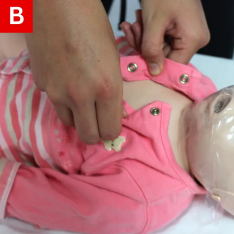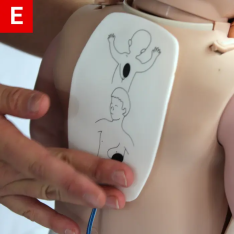- Automated External Defibrillator (AED) Infants & Children
Automated External Defibrillator (AED) Infants & Children
An AED can be used on children and infants and should be used as early as possible for the best chance of improving the chance of survival. Check the AED when it arrives at the scene. Pediatric pads should be used if the person is less than eight years old or less than 55 pounds (25 kg). Standard (adult) pads may be used if pediatric pads are not available. If using standard (adult) pads, do not let the pads touch. For infants less than a year old, a manual defibrillator should be used if available. If a manual defibrillator is not available, an AED may be used. Some AEDs have a switch that can be set to deliver a pediatric shock. If available, turn the switch on when using on children younger than eight years old. If the AED cannot deliver a pediatric shock, an adult shock should be given. It is important to remember an electric shock may be the treatment for a fatal heart rhythm.


AED STEPS FOR CHILDREN AND INFANTS
- Retrieve the AED (Figure 12a).
- Open the case.
- Turn on the AED.
- Expose the person’s chest (Figure 12b).
- If wet, dry the chest.
- Remove any medication patches.






- Open the Pediatric AED pads (Figure 12c).
- Peel off backing.
- Check for pacemaker or implanted defibrillator.
- Apply the pads (Figure 12d).
- Apply one pad on the upper right chest above the breast. For infants, apply on the front of the chest.
- Apply the second pad on the lower left chest below the armpit. For infants, apply a second pad to the back (Figure 12e).
- Ensure wires are attached to the AED box (Figure 12f).
- Move away from the child (Figure 12g).
- Stop CPR.
- Instruct others not to touch the child.
- Let AED analyze the rhythm.
- If the AED message reads “Check Electrodes,” then:
- Ensure electrodes make good contact (Figure 12f).
- If the AED message reads “Shock”, then:
- Press and hold the flashing shock button until the shock is delivered.
- Resume CPR for two minutes starting with chest compressions (Figure 12h).
- Repeat steps 1-10.
